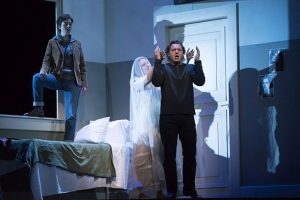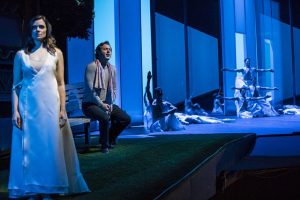RECOMMENDED

An extraordinary pairing of the Joffrey Ballet with the exceptional voice of tenor Dimitry Korchak opened Lyric Opera’s 2017-2018 season Saturday, Sept. 23.
The opera is the August 1774 Paris version of Chrisoph Willibald Gluck’s ‘Orphée et Eurydice’ with a libretto by Pierre-Louis Moline. However, the production is all John Neumeier.
Longtime director and chief choreographer of the Hamburg Ballet, Neurmeier did the choreography, set, lighting and costume design and directed the production.
In his contemporary production, Orphée is a choreographer rehearsing a ballet based on Arnold Bocklin’s painting, “The Isle of the Dead.” His wife, Eurydice, is his star but when she arrives late they argue and she storms off.
After an impressive auto crash that pushes through the scenery, Eurydice is shown thrown from the car and dead on the ground.
Orphée’s assistant is a jean-clad Amour, with a sprite-like Peter Pan quality. Armour tells him to go to Hades and bring back Eurydice.
Mirrored moving panels create an interesting background in the rehearsal studio. That is, except when they reflect the lights from the opera house’s tiers.

Grey and white cutaway panels provide spaces that allow a small stage focus on Orphées bedroom and a moving path for him and Eurydice to wander from Elysium back to life on earth.
Even with its modern take, audiences delighted to get both world-class ballet with the exquisite voices of Korchak as Orphée, Andriana Chuchman as Eurydice and Lauren Snouffer as Amour, will love the entire experience.
Guests who normally come just for the opera, might find some of the ballet sequences and meanderings to be a bit lengthy. Gluck added ballet sequences to this version including the “Dance of the Furies” and the “Dance of the Blessed Spirits.” The final dance sequence of Orphée’s ballet is also very long.
Even though the Joffrey dancers perfectly execute what was choreographed, viewers might wonder at some of the mechanical-toy style of some of the movements in the “Dance of the Furies” and at the mix of traditional and contemporary ballet.
The story, frequently told in opera, theater and literature, goes back to Greek mythology when Orpheus, son of Apollo, falls in love and marries the beautiful Eurydice. But when she dies (by a snake bite in the story and a car accident in the Lyric opera) Orpheus is told by Apollo in the myth but by Amour (think Cupid or Eros) in the Lyric opera to go to Hades and try to bring her back.

The myth has Orpheus making his way past the Furies and the three-headed Cerberus (three dancers) through his beautiful playing of lyre. He does so in this opera version with his sorrowful singing.
The obstacle is he can only take Eurydice back with him if he doesn’t look at her or explain that as she follows him out. Eurydice doesn’t understand so cries and bitterly complains until he finally can’t resist so looks back and she dies. Orpheus leaves alone.
At the Lyric Korchak beautifully sings “Che farò senza Euridice?”/”J’ai perdu mon Eurydice” (“What shall I do without Euridice?”/”I have lost my Euridice”). Earlier, before going to Hades, he expressed his love in the magnificent aria “Chiamo il mio ben”/”Objet de mon amour.”
In one version Amour feels sorry for him and returns Eurydice to life. In the Neumeier production, she is returned as a ghostly spirit in his heart and in the ballet he created.
During the ballet Victoria Jaiani and partner Temur Suluashvili, are “doubles” of Eurydice and Orphée.
Through it all are the wonderful voices of the Lyric Opera Chorus who are in the pit with maestro Harry Bicket and the fine orchestra.
DETAILS: “Orphee et Eurydice” by Chrisoph Willibald Gluck’s, is at the Lyhric Opera House, 20 N. Wacker Dr., through Oct. 15, 2017. Running time: 2 hours, 20 minutes with one intermission. For tickets and other information visit Lyric Opera.
